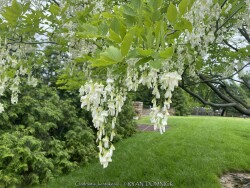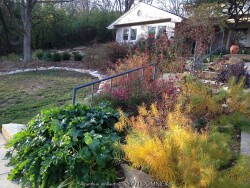

Bear's Breeches / Acanthus is a clump-forming perennial that is grown as much for its attractive dark green foliage as for its architecturally bold flower spikes. It is native to the Mediterranean region. Flowers are creamy white (sometimes pinkish) and snapdragon-like. Foliage is mostly evergreen in warm winter climates, but plants lose their leaves when winter temperatures dip below 20°F. Foliage is usually persisting until mid-early December in Kansas. If low temperatures hit -10 degrees F, it may kill an un-mulched plant; protect any zone 6 perennial with thick layer of mulch. Established plants survived -16 degrees F and a week of single digit highs in February, 2021. Acanthus may be grown a potted patio plant for full to part shade. Grown in a raised pot, they are hardy to about 15-20° so you may be able to miss the first few frosts when moving them in for the winter. Before extreme cold, overwinter in a dark garage or basement with monthly watering to encourage dormancy. Alternatively, it can maintain growing in a bright window as a houseplant. Either way, they will hold up very well in the winter and maintain their attractive foliage. In spring, just cut off dead foliage and place back out in April or May with a time-release fertilizer.
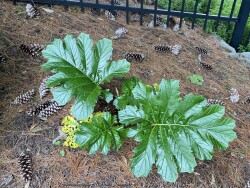

Bear's Breeches / Acanthus is a clump-forming perennial that is grown as much for its attractive dark green foliage as for its architecturally bold flower spikes. It is native to the Mediterranean region. Flowers are creamy white (sometimes pinkish) and snapdragon-like. Foliage is mostly evergreen in warm winter climates, but plants lose their leaves when winter temperatures dip below 20°F. Foliage is usually persisting until mid-early December in Kansas. If low temperatures hit -10 degrees F, it may kill an un-mulched plant; protect any zone 6 perennial with thick layer of mulch. Established plants survived -16 degrees F and a week of single digit highs in February, 2021. Acanthus may be grown a potted patio plant for full to part shade. Grown in a raised pot, they are hardy to about 15-20° so you may be able to miss the first few frosts when moving them in for the winter. Before extreme cold, overwinter in a dark garage or basement with monthly watering to encourage dormancy. Alternatively, it can maintain growing in a bright window as a houseplant. Either way, they will hold up very well in the winter and maintain their attractive foliage. In spring, just cut off dead foliage and place back out in April or May with a time-release fertilizer. Acanthus mollis 'Wofford Rhubarb' features beautiful red leaf stalks.
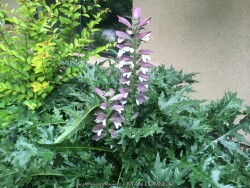

Spiny Bear's Breeches (Acanthus spinosus) is a clump-forming perennial that is grown as much for its attractive dark green foliage as for its architecturally bold flower spikes. The foliage of this species deeply cut and rather spiny looking dark-green leaves without actual spines. Flowers are creamy white (sometimes pinkish) and snapdragon-like and DO have sharp spines! It is the most thistly-looking of any of the various forms available. Foliage is mostly evergreen in warm winter climates, but plants lose their leaves when winter temperatures dip below 20°F. Foliage is usually persisting until mid-early December in Kansas. If low temperatures hit -10 degrees F, it may kill an un-mulched plant; protect any zone 6 perennial with thick layer of mulch. Established plants survived -16 degrees F and a week of single digit highs in February, 2021.
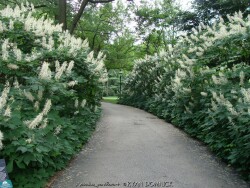

This species (Aesculus parviflora) grows as a large suckering deciduous shrub in evenly moist, well-drained soils in part shade to full shade. The species is native to the southeastern United States, where it is found primarily in Alabama and Georgia but is hardy much further North to zone 5. Useful in Kansas landscapes in rich established forest areas or along stream banks with plenty of room. Tends to thrive in rich forest soils of Eastern Kansas just fine without irrigation but is not known to tolerate moderate to drought. Bottlebrush buckeye features large palmate green leaves and tall cylindrical panicles (to 12" long) of tubular white flowers with conspicuous red anthers and pinkish filaments. Mid-summer bloom will not go unnoticed!
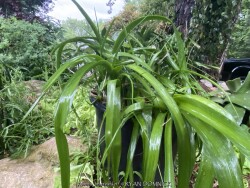

Pregnant Onion (Albuca bracteata) is typically grown in warmer zones. Considered a tropical or succulent in Kansas and used as summer patio plants with white flowers and bright green foliage. Be prepared to give away offset bulblets to all your friends! Water sparingly and place in full sun to mostly shade. Pregnant Onion can tolerate frost but protect from temperatures below 25 degrees F and move into a cold garage or basement over the winter with minimal watering. Do not allow the pot with rootball to freeze solid or go below 23 degrees for more than a few hours. Allow to go dormant with little care, just cut off dead foliage and place back out in April or May with a time-release fertilizer. Repotting may or may not be needed depending on how large you want the plant to grow; plants can continue to grow taller and tolerate extremely root-bound pots but may need wind bracing. If repotting, make sure to use a sharp draining medium organic cactus mix with plenty of sand and perlite.
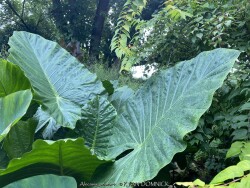

Odora Elephant Ear (Alocasia odora) is typically grown in warmer zones and features giant glossy green leaves creating quite a contrast for other colorful flowers in the garden. Most alocasia are large tropical and subtropical herbaceous perennials with a giant tubers native to areas with a summer monsoon and dry winter. Along with other tropicals and succulents in Kansas, elephant ears are usually grown as summer patio plants. Fertilize, water regularly, and place in full sun. Protect from temperatures below 28 degrees F and move into a cold garage or basement over the winter with minimal watering. Do not allow the pot with rootball to freeze solid or go below 25 degrees for more than a few hours. Allow to go dormant as needed with little care, just cut off dead foliage and place back out in April or May with a time-release fertilizer. Many plants will die back slowly and remain attractive inside for most of the winter. You may also plant these in the ground for an enormous tropical effect! It is possible to overwinter these in the ground in Kansas by placing a giant 12-18" mound of mulch over deeply planted rhizomes. New growth will usually be delayed until June but quickly regains full height. In our trial gardens in Lawrence, KS (zone 6a), three established specimens planted over 12" deep and mulched 6-12" with leaf mulch survived -17 degrees F. During the arctic blast of February, 2021, lows down to -17 degrees F on Feb 16th, 2021 were recorded. The longevity of this cold blast was also impressive: 10 days on a row with highs of 10-15 degrees F or lower, 8 nights of lows in the single digits and negatives, and 36 strait hours of 0 degrees F and mostly lower.
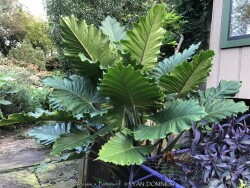

Portora Elephant Ear (Alocasia x Portora) is typically grown in warmer zones and features giant glossy green leaves creating quite a contrast for other colorful flowers in the garden. Most alocasia are large tropical and subtropical herbaceous perennials with a giant tubers native to areas with a summer monsoon and dry winter. Along with other tropicals and succulents in Kansas, elephant ears are usually grown as summer patio plants. Fertilize, water regularly, and place in full sun. Protect from temperatures below 28 degrees F and move into a cold garage or basement over the winter with minimal watering. Do not allow the pot with rootball to freeze solid or go below 25 degrees for more than a few hours. Allow to go dormant as needed with little care, just cut off dead foliage and place back out in April or May with a time-release fertilizer. Many plants will die back slowly and remain attractive inside for most of the winter. You may also plant these in the ground for an enormous tropical effect! It is possible to overwinter these in the ground in Kansas by placing a giant 12-18" mound of mulch over deeply planted rhizomes. New growth will usually be delayed until June but quickly regains full height. This plant can also grow in standing water or as a potted plant in water gardens.
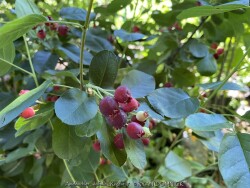

This serviceberry (Amelanchier alnifolia 'Regent') is a shrub to dwarf tree form with edible bluish-purple berry-like fruit, native to North America from Alaska across most of western Canada and in the western and north-central United States. Although it is adaptable to a variety of soil and moisture conditions, it shows some drought intolerance so go with sand plums on a drier site. The delicious fruit of this and related species are eaten fresh or prepared in puddings and pies. You need to act quick before the birds strip them clean. 'Regent' is a compact, deciduous, stoloniferous, early-flowering cultivar which typically grows only 4-6' tall. Great plant for the edible landscape!
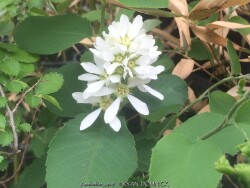

This serviceberry (Amelanchier canadensis) is a deciduous, early-flowering, large shrub or small tree which typically grows 15-25' tall with edible red to bluish-purple berry-like fruit. Native to Eastern North America. Although it is adaptable to a variety of soil and moisture conditions, it shows some drought intolerance so go with sand plums or American plums on a drier site. The delicious fruit of this and related species are eaten fresh or prepared in puddings and pies. You need to act quick before the birds strip them clean. Amelanchier canadensis is also called Shadblow Serviceberry. Great plant for the edible landscape!
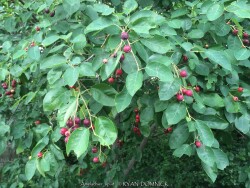

Serviceberry (Amelanchier sp.) can be a shrub or dwarf tree form with edible red to bluish-purple berry-like fruit, native to North America from Alaska across most of western Canada and in the western and north-central United States. Although it is adaptable to a variety of soil and moisture conditions, it shows some drought intolerance so go with sand plums on a drier site. The delicious fruit of this and related species are eaten fresh or prepared in puddings and pies. You need to act quick before the birds strip them clean. Great plant for the edible landscape!


This serviceberry (Amelanchier x grandiflora 'Autumn Brilliance') is a deciduous, early-flowering, large shrub or small tree which typically grows 15-25' tall with edible red to bluish-purple berry-like fruit. Native to Eastern North America. Although it is adaptable to a variety of soil and moisture conditions, it shows some drought intolerance so go with sand plums or American plums on a drier site. The delicious fruit of this and related species are eaten fresh or prepared in puddings and pies. You need to act quick before the birds strip them clean. Amelanchier x grandiflora is a hybrid cross between two species of North American serviceberry, namely, A. arborea (downy serviceberry) and A. laevis (Allegheny serviceberry). 'Autumn Brilliance' has brilliant orange-red fall color. Great plant for the edible landscape!


***Description for this hardy tropical available with future update!***>>>>> Plant Delights Nursery says "This little-known but easy-to-grow voodoo lily is native to the Yunnan Province of China. The stalks are either solid green or green with grey spots and are each topped with a glossy green leaf. Amorphophallus albus is a fast offsetting species that forms a nice 2' wide patch (in 5 years) in the woodland garden. In spring, just as the leaf emerges, a 1' tall flower stalk appears alongside it with a 6-8" tall flower perched on top. Each flower resembles a large ivory shell showcasing a white, cigar-like appendage...green at the tip and white at the base." >>>>>>>>>> Voodoo (Amorphophallus konjac) lily is a perennial tuber generally grown as a curiosity for its interesting foliage. The single leaf consists of a stalk (petiole) with mottled pinkish-gray and olive green coloration. The single intricate leaf has horizontal sections giving it a tropical umbrella-like effect. Larger tubers (about the size of a grapefruit or larger) may produce a single "flower" in spring before the foliage appears. The "flower" is actually a large shiny purple to maroon ruffled spathe. When in bloom it produces an odor like a dead animal for 1 day. This is intended to attract the carrion flies that are its natural pollinators. It is possible to overwinter these in the ground in Kansas by placing a 6-12" mound of mulch over deeply planted tubers. New growth will usually be delayed until June but quickly regains full height and will get bigger each year; buried tubers are hardy to zone 6a. They can also be grown as a flowering summer patio plant. If growing as a potted plant and trying to overwinter, allowing the foliage to frost is ok, it will not kill the root system. However, do not allow the pot with rootball to freeze solid or go below 20 degrees for more than a few hours; move into a cold garage or basement over the winter with no watering. Cut back and allow to go dormant and place entire pot back out in April or May with a time-release fertilizer. Plants can get huge and exotic looking as a potted patio plant. Grown in Japan and Korea as an edible corm. Testing in Lawrence KS display gardens has been successful; surviving temperatures of -11F (2024)
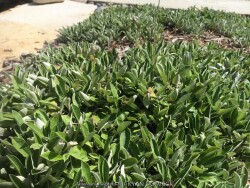

Pussytoes (Antennaria neglecta) are also known for their soft, silvery basal leaves, which spread to form a low groundcover in dry areas. Weeds have a hard time colonizing this groundcover in dry poor soil areas. Absolutely avoid planting pussytoes in moist soils or areas that have poor drainage or death will quickly occur. Native habitat across much of the Midwest and Northeast includes medium to dry black soil prairies, clay prairies, open woodlands and dry meadows. In Kansas landscapes, use as a retaining wall rock garden plant, a stepable groundcover along path, or in-between stepping stones in gravely well drained soils. Pussytoes is named for its white tufted flowers that look like tiny cat's feet. Flowers are interesting but generally best to cut before seed set as they detract from the tidy mat-like foliage. Antennaria neglecta has tiny foliage.
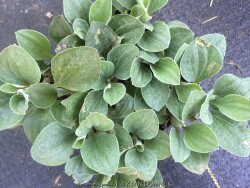

Pussytoes (Antennaria parlinii) are also known for their soft, silvery basal leaves, which spread to form a low groundcover in dry areas. Weeds have a hard time colonizing this groundcover in dry poor soil areas. Absolutely avoid planting pussytoes in moist soils or areas that have poor drainage or death will quickly occur. Native habitat across much of the Midwest and Northeast includes medium to dry black soil prairies, clay prairies, open woodlands and dry meadows. In Kansas landscapes, use as a retaining wall rock garden plant, a stepable groundcover along path, or in-between stepping stones in gravely well drained soils. Pussytoes is named for its white tufted flowers that look like tiny cat's feet. Flowers are interesting but generally best to cut before seed set as they detract from the tidy mat-like foliage. Antennaria parlinii has larger foliage and is more shade tolerant; a great plant for dry-shade.
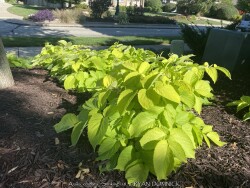

Sun King Aralia (Aralia cordata 'Sun King') is unique golden-leafed variety for the shade. The color will be brighter yellow and gold with pink leaf stalks in part sun, and more chartreuse or lime green in full shade. Tiny white flowers are insignificant and even a distraction to the gorgeous foliage. After blooming, deep purplish black, inedible berries are mildly attractive but not jaw-dropping. This unique perennial grows best in part to light shade tolerating mild drought, though if given consistent moisture it can also grow in mostly full sun. It prefers richly organic, deep loamy soil that is moist but well-drained. It typically dies back to the ground in early fall needing to be cut back then often leaving a late-season void in the garden. It re-emerges in spring to quickly form a beautiful shrub-like clump. Cold tolerance is no problem. It survived -16 degrees F and a week of single digit highs in February, 2021. No disease or pest problems other than late-season foliage decline. In Eastern Kansas, typically our 40 inches of rainfall is sufficient without extra water if planted in good soils. This is a must-have for the shade garden; combine with hostas, solomon's seal, helleborus, or ferns! Also great with shrubs such as boxwood or viburnum.
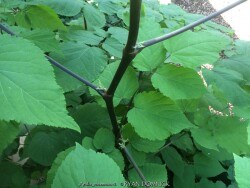

American Spikenard (Aralia racemosa) matures to 3-5' in height and has green flowers with attractive reddish purple berries in early fall. Spikenard is a true herbaceous perennial in that it dies back each fall and emerges from the ground up each spring. So large and broad, it is sometimes confused for a woodland shrub. It prefers wet to medium soil but tolerated dry-shade when mature in rich clay soils. Many woodland plants have already finished flowering when Spikenard blooms and shows off its beautiful berries. Cut the entire plant down in fall as there is no winter interest. In Kansas landscapes, use in Woodland gardens, sun dappled shade gardens, naturalized areas, wild gardens and native plant gardens. Plant as a specimen focal point or small grouping backdrop for shorter plants to contrast in the shade garden.
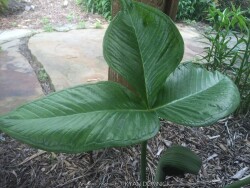

Japanese Cobra Lily (Arisaema ringens) is planted for its bright green foliage and bazaar "Cobra" hood-like flowers. Native to rich Japanese forests in humusy, medium to wet, well-drained soil in part shade to full shade, it needs a good location in the garden and will be a focal point. If foliage depreciates from drought, the plants may be cut to the ground with some regrowth and flowering possible in the fall. Combine with shade garden plants that will fill the space in summer such as hostas. Although this aroid offsetts, it is rare and uncommonly available for sale.
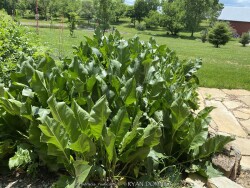

Horseradish (Armoracia rusticana) is a large tropical looking plant features large, variably sized 18-24" long, shiny, dark green leaves (resembling Silphium). It is also a perennial vegetable that is grown for its pungent, fleshy roots which are harvested and grated to make sauces. Insignificant, whitish flowers which appear in summer. Beware that this is an extremely vigorous plant that crowds out most weeds and is itself weed-like, with a very spreading growth habit. Best planted and allowed to grow as large isolated clumps, mowing around it generally stops the yearly spread. Included in our "edibles" plant database section.


Red chokeberry (Aronia arbutifolia 'Brilliantissima'), is an open, upright, spreading, somewhat rounded but leggy, suckering, deciduous shrub that typically grows 6-10' tall. It is native to native to both wet and dry thickets in Eastern North America. This 3-season shrub had appeal from spring to late fall starting with white flowers, then deep green summer foliage followed by brilliant red fall color and red berries. Plant in groups or mass plantings in small gardens or open woodland areas. Ability to withstand wet conditions makes it suitable for growing on the margins of ponds, streams, or rain gardens. Watch out for deer can devour young plants (protect with chicken wire if needed) but established plantings can generally outgrow deer browsing which offer free pruning to prevent legginess. The common name of chokeberry is in reference to the tart and bitter taste of the fruits which are edible but so astringent as to cause choking in most of those who try: no it's not poison!. Fruits are renowned for its antioxidant rich berries and high nutritional value and sometimes used to make tasty jams and jellies if enough sugar is added. Included in our "edibles" database but depends on how hungry you are! Aronia arbutifolia 'Brilliantissima' grows slowly to 6-8' tall and is perhaps most noted for its attractive glossy red berries and red fall foliage color. It primarily differs from the species by being more compact. It producing more lustrous foliage with superior red fall color. It also produces larger, glossier and more abundant fruit favored by wildlife.
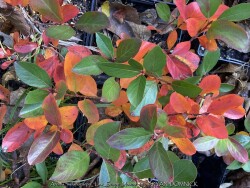

Low Scape Mound Aronia (Aronia melanocarpa 'Low Scape Mound') is a tidy little mound shaped deciduous shrub that typically grows 1-2' tall. It is native to low woods, swamps, bogs and moist thickets native from the Midwest to Canada. This 3-season shrub had appeal from spring to late fall starting with white flowers, then deep green summer foliage followed by brilliant red fall color and a few blackberries. Plant in small groups or mass plantings in small gardens. Ability to withstand wet conditions makes it suitable for growing on the margins of ponds, streams, or rain gardens. Despite 'Low Scape Mound' being touted as "drought tolerant", in the southern part of their range (Kansas), this chokeberry will decline in dry clay or alkaline soils. Watch out for deer and rabbits can devour young plants (protect with chicken wire if needed) but established plantings can generally outgrow browsing. The common name of chokeberry is in reference to the tart and bitter taste of the fruits which are edible but so astringent as to cause choking in most of those who try: no it's not poison!. Fruits are renowned for its antioxidant rich berries and high nutritional value and sometimes used to make tasty jams and jellies if enough sugar is added. Included in our "edibles" database but depends on how hungry you are! However, 'Low Scape Mound' is not grown for fruit production but rather as a compact landscape 3-season shrub tolerant of wet soils. All Proven Winners® plants are legally propagated, healthy and vigorous, true to name, and tagged with color pictures and growing information.


Low Scape Snowfire Aronia (Aronia melanocarpa 'Low Scape Snowfire') compact mound shaped deciduous shrub that typically grows 3-5' tall. It is native to low woods, swamps, bogs and moist thickets native from the Midwest to Canada. This 3-season shrub had appeal from spring to late fall starting with numerous white flowers, then deep green summer foliage followed by brilliant red fall color and a few blackberries. Plant in small groups or mass plantings in small gardens. Ability to withstand wet conditions makes it suitable for growing on the margins of ponds, streams, or rain gardens. Despite 'Low Scape Snowfire' being touted as "drought tolerant", in the southern part of their range (Kansas), this chokeberry will decline in dry clay or alkaline soils. Watch out for deer and rabbits can devour young plants (protect with chicken wire if needed) but established plantings can generally outgrow browsing. The common name of chokeberry is in reference to the tart and bitter taste of the fruits which are edible but so astringent as to cause choking in most of those who try: no it's not poison!. Fruits are renowned for its antioxidant rich berries and high nutritional value and sometimes used to make tasty jams and jellies if enough sugar is added. Included in our "edibles" database but depends on how hungry you are! However, 'Low Scape Snowfire' sets a heavy crop for fruit production but rather as a compact landscape 3-season shrub tolerant of wet soils. All Proven Winners® plants are legally propagated, healthy and vigorous, true to name, and tagged with color pictures and growing information.
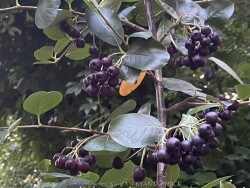

Black Chokeberry (Aronia melanocarpa), is an open, upright, spreading, somewhat rounded but leggy, suckering, deciduous shrub that typically grows 3-6' tall. It is native to low woods, swamps, bogs and moist thickets native from the Midwest to Canada. This 3-season shrub had appeal from spring to late fall starting with white flowers, then deep green summer foliage followed by brilliant red fall color and black berries. Plant in groups or mass plantings in small gardens or open woodland areas. Ability to withstand wet conditions makes it suitable for growing on the margins of ponds, streams, or rain gardens. Watch out for deer can devour young plants (protect with chicken wire if needed) but established plantings can generally outgrow deer browsing which offer free pruning to prevent legginess. The common name of chokeberry is in reference to the tart and bitter taste of the fruits which are edible but so astringent as to cause choking in most of those who try: no it's not poison!. Fruits are renowned for its antioxidant rich berries and high nutritional value and sometimes used to make tasty jams and jellies if enough sugar is added. Included in our "edibles" database but depends on how hungry you are! 'Viking' was developed in Europe for production of extra large dark purple-black fruit also used as a component of health drink juices. Aronia melanocarpa 'Viking' black chokeberry produces abundant fruit and improved fall color. Cross pollination on both varieties increases fruit production although both are self-fertile.
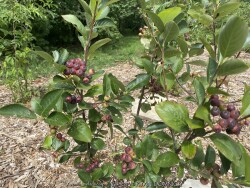

Black Chokeberry (Aronia melanocarpa), is an open, upright, spreading, somewhat rounded but leggy, suckering, deciduous shrub that typically grows 3-6' tall. It is native to low woods, swamps, bogs and moist thickets native from the Midwest to Canada. This 3-season shrub had appeal from spring to late fall starting with white flowers, then deep green summer foliage followed by brilliant red fall color and black berries. Plant in groups or mass plantings in small gardens or open woodland areas. Ability to withstand wet conditions makes it suitable for growing on the margins of ponds, streams, or rain gardens. Watch out for deer can devour young plants (protect with chicken wire if needed) but established plantings can generally outgrow deer browsing which offer free pruning to prevent legginess. The common name of chokeberry is in reference to the tart and bitter taste of the fruits which are edible but so astringent as to cause choking in most of those who try: no it's not poison!. Fruits are renowned for its antioxidant rich berries and high nutritional value and sometimes used to make tasty jams and jellies if enough sugar is added. Included in our "edibles" database but depends on how hungry you are! 'Viking' was developed in Europe for production of extra large dark purple-black fruit also used as a component of health drink juices.
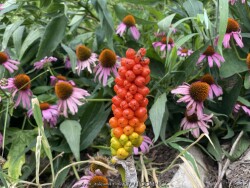

Italian Painted Arum (Arum italicum 'Pictum') is native to the Mediterranean region. It has a reversed or off-schedule life cycle; growing when other plants have already shed their leaves to take advantage of sunlight and lack of competition. It is often planted for its unusual evergreen leaf pattern and color resembling a bright green house plant growing outside in winter. Foliage goes dormant by June but is followed by naked stalks emerging from the ground with reddish orange berries. Foliage re-appears in fall and lasts well into winter untouched. If low temperatures hit 0 degrees F, foliage finally dies back to the ground and re-emerges in early spring to repeat the life cycle. If low temperatures hit -15 degrees F, it may kill an un-mulched plant; protect any zone 5/6 perennial with a 2-3" thick layer of mulch. Grow in average to rich well drained garden soil in full sun or full shade with everything in between. Moderate dry shade does not seem to be a problem because arum goes dormant anyways in the heat of summer. This holds true for planting in sunny locations to. Combine with shade garden plants that will fill the space in summer such as hostas or solomon seal. Also great when combined with late-emerging spring perennials (like plumbago, hardy hibiscus, and orange butterfly weed) because it fills that early spring space starting to grow extremely early with freeze-resistant foliage. Then later in the summer when Arum goes dormant, these plants hide the dying foliage and void left in the garden; what a great way for two species to share the same garden space! It has potential to be invasive in parts of the country such as the Pacific Northeast USA but not in Kansas. It is very stable but does not self-seed or spread in Lawrence, KS gardens; bulb offsets develop but only thicken the existing clump over time. Considered to be a great permatanet multi-season perennial for your garden.
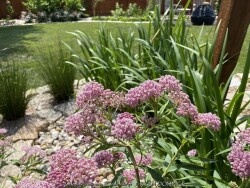

Pink Swamp Milkweed (Asclepias incarnata) is a herbaceous perennial plant species native to North America. The foliage is bright green and upright. The blooms occurring in early to mid-summer are pink to mauve (sometimes white). After blooming, green seed pods are attractive. They finally split open in late summer releasing silver fluffy floating seeds that are whisked away in the wind. This same natural mechanism for seed dispersal is similar to that used by most other milkweed (Asclepias) species. Fall color is an attractive yellow to gold with red highlights. It is frequently grown as a bog plant needing constantly moist soil rich in organic matter. As a rain garden plant, it will thrive is a depressed area in the landscape that collects rain water from a roof during spring and summer periods of rain but then go dormant if the water hole dries out completely. This species is not shade-tolerant and will get crowded out if the rain garden becomes too dense. Pink Swamp Milkweed may also be grown in average garden soils provided extra water is supplied during droughts. It is cultivated as a garden plant for butterflies and birds at all life stages: foliage for caterpillars, nectar for butterflies and other insects, and seeds for birds. It has a latex sap containing toxic chemicals that helps it repel other insects and other herbivorous animals. In the home landscape, this species does not spread like some other milkweeds. The plant is also timid about self-seeding because seeds have to germinate in mud and quickly die if it dries out. No worries about invasiveness with this one, just count on it being a beautiful tall perennial for many years in the garden! The species is not shade-tolerant and is not a good vegetative competitor.
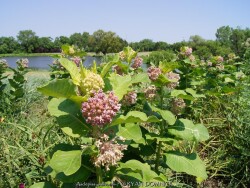

***Description for this perennial available with future update!***


***Description for this perennial available with future update!***
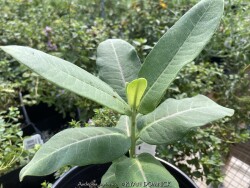

***Description for this perennial available with future update!***
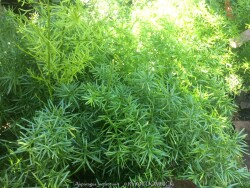

***Description for this plant available with future update!***
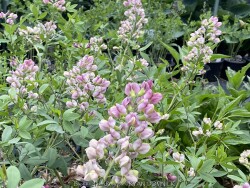

The False Indigo species (Baptisia) features beautiful compact bluish green leaves arranged in groups of three. Like many members in the legume family, they are nitrogen fixing plants which means they produce their own nitrogen in the soil through a symbiotic relationship with bacteria. The flowers bloom above the foliage normally in April and May. Common baptisia flower colors include white, purple, lavender, yellow, and pink as well as uncommon colors ranging from deep purple to maroon and even coppery orange. Considered a great North American native three season plant, the foliage always emerges very attractive followed by flowers that do not need deadheading. Foliage generally lasts pretty nice through hot summers and into fall turning black with first freeze. Seed pods also turn charcoal black when ripe and have considerable ornamental interest and useful in dried flower arrangements. At some point in the fall, it can be cut down early for a clean look or left for winter interest. Baptisia generally do well in droughty clay soils in full to part sun. There is only one pest that may create problems called the Genista Broom Moth. It may occur in Kansas when weather conditions are consistently dry and over 95 degrees F. It is treatable if you act fast but if not, it only destroys the foliage late in the season and does not kill the plant. Baptisia has several enormous spreading taproots which store water and energy and can make transplanting difficult. Plantings look good as specimen or in small groups; and it's ok even preferable if they grow together and touch other plants. That helps eliminate available sunlight and discourages weeds. It is hard to picture a native plant garden or any perennial garden without Baptisia. Considered a once "it's there, it's always there" long lived plant. Baptisia 'Plum Rosy' is an excellent vigorous pink and white flowered selection; quite a color break-thru for Baptisia! Pink blossoms age to white creating a bi-colored effect in late spring on bright green foliage. This full-size but dense habit can work like a shrub in any garden. This extremely long-lived perennial could be used instead of a shrub in landscape settings, with minimal care required to thrive year after year. This plant was introduced from Walters Gardens, Inc.
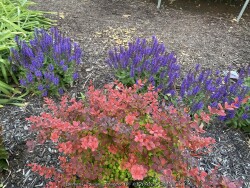

Bright and cheery, this new barberry (Berberis 'Sunjoy Tangelo') has vivid orange new growth that develops a distinctive chartreuse margin as the season goes on. Sunjoy® Tangelo Barberry is stronger growing than other variegated cultivars, it is colorful in the landscape from spring to fall. Certified wheat-rust resistant. Maintenance Notes: Prefers well-drained soils. May be pruned to shape in summer. In Eastern Kansas, this cultivar performs WELL with just about everything nature has to challenge it! Heat and drought are tolerated well. Cold tolerance is no problem. No disease or pest problems. Great plant for berms in full sun. No other plant can match its bright orange-red foliage: I personally love the combination of planting next to blue or purple flowers but the combinations are endless! All Proven Winners® plants are legally propagated, healthy and vigorous, true to name, and tagged with color pictures and growing information.
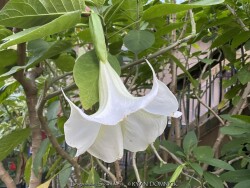

Brugmansia is a genus of seven species of flowering plants in the nightshade family Solanaceae from South America. It is typically grown in warmer zones as a shrub or tree but is extinct from the wild (only known in cultivation). Along with other tropicals and succulents in Kansas, Angel Trumpet Flower is usually grown as summer patio plant with amazing foot-long hanging flowers and sweet aroma. Water regularly and place in full sun or part shade. Protect from temperatures below 32 degrees F and move into a cold garage or basement over the winter with minimal watering. Do not allow the pot with rootball to freeze solid or go below 28 degrees for more than a few hours. Allow to go dormant as needed with little care, just cut off dead foliage/twigs and place back out in April or May with a time-release fertilizer. You may also propagate this plant easily by cutting off dormant twigs/branches and stuffing them into the ground. Notice that I didn't say rooting hormone or even being careful was necessary! Landscapers also plant these as an annual in the ground for an enormous tropical effect with fragrant flowers and growth reaching 5-8' in one season from a 1gal container! It is possible to overwinter Brugmansia in the ground in Kansas as a woody perennial. In our trial gardens in Lawrence, KS (zone 6a), a one year established specimen planted in our annual bed was mulched 12-18" thick with leaf mulch survived -10 degrees F. The dieback was deep into the ground but somehow came back from a piece of deep root. The leaf mulch was also well rotted and formed somewhat of an ice barrier insulating effect. Brugmansia species are amongst the most toxic of ornamental plants so do not eat and part of this plant! Brugmansia 'Snowflake' features pure white flowers. Our plant came from Brian's Botanicals in Kentucky.
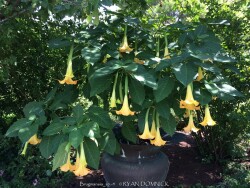

Brugmansia is a genus of seven species of flowering plants in the nightshade family Solanaceae from South America. It is typically grown in warmer zones as a shrub or tree but is extinct from the wild (only known in cultivation). Along with other tropicals and succulents in Kansas, Angel Trumpet Flower is usually grown as summer patio plant with amazing foot-long hanging flowers and sweet aroma. Water regularly and place in full sun or part shade. Protect from temperatures below 32 degrees F and move into a cold garage or basement over the winter with minimal watering. Do not allow the pot with rootball to freeze solid or go below 28 degrees for more than a few hours. Allow to go dormant as needed with little care, just cut off dead foliage/twigs and place back out in April or May with a time-release fertilizer. You may also propagate this plant easily by cutting off dormant twigs/branches and stuffing them into the ground. Notice that I didn't say rooting hormone or even being careful was necessary! Landscapers also plant these as an annual in the ground for an enormous tropical effect with fragrant flowers and growth reaching 5-8' in one season from a 1gal container! It is possible to overwinter Brugmansia in the ground in Kansas as a woody perennial. In our trial gardens in Lawrence, KS (zone 6a), a one year established specimen planted in our annual bed was mulched 12-18" thick with leaf mulch survived -10 degrees F. The dieback was deep into the ground but somehow came back from a piece of deep root. The leaf mulch was also well rotted and formed somewhat of an ice barrier insulating effect. Brugmansia species are amongst the most toxic of ornamental plants so do not eat and part of this plant! Flowers come in Orange, Red, Pink, and White.


Brugmansia is a genus of seven species of flowering plants in the nightshade family Solanaceae from South America. It is typically grown in warmer zones as a shrub or tree but is extinct from the wild (only known in cultivation). Along with other tropicals and succulents in Kansas, Angel Trumpet Flower is usually grown as summer patio plant with amazing foot-long hanging flowers and sweet aroma. Water regularly and place in full sun or part shade. Protect from temperatures below 32 degrees F and move into a cold garage or basement over the winter with minimal watering. Do not allow the pot with rootball to freeze solid or go below 28 degrees for more than a few hours. Allow to go dormant as needed with little care, just cut off dead foliage/twigs and place back out in April or May with a time-release fertilizer. You may also propagate this plant easily by cutting off dormant twigs/branches and stuffing them into the ground. Notice that I didn't say rooting hormone or even being careful was necessary! Landscapers also plant these as an annual in the ground for an enormous tropical effect with fragrant flowers and growth reaching 5-8' in one season from a 1gal container! It is possible to overwinter Brugmansia in the ground in Kansas as a woody perennial. In our trial gardens in Lawrence, KS (zone 6a), a one year established specimen planted in our annual bed was mulched 12-18" thick with leaf mulch survived -10 degrees F. The dieback was deep into the ground but somehow came back from a piece of deep root. The leaf mulch was also well rotted and formed somewhat of an ice barrier insulating effect. Brugmansia species are amongst the most toxic of ornamental plants so do not eat and part of this plant! Flowers come in Orange, Red, Pink, and White.
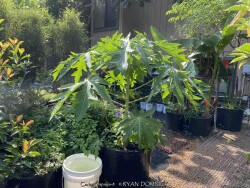

***Description for this plant available with future update!***Papaya (Tropical), is also known as Carica papaya


The Saguaro Cactus (Carnegiea gigantea) is probably the most well known iconic cactus out there. Native to the Sonoran Desert in Arizona and Mexico, it's usually grown as a patio or house plant in Kansas. In the wild, established saguaro cacti are hardy to 15 degrees F for short periods of time making them the most cold tolerant columnar tree cactus out there. Growth rates are astonishingly slow: a plant the size od a softball may already be 10-15 years old. A 12" tall specimen may be 20-30 years old. The first arm usually develops around 75 years and plants can live for 200-300 years in hte wild. Grow in full sun with no extra watering except that which comes from rainfall. Repotting may or may not be needed depending on how large you want the plant to grow; plants can continue to grow taller and tolerate extremely root-bound pots but may need wind bracing. If repotting, make sure to use a sharp draining low organic cactus mix with plenty of sand and perlite. Potted plants are hardy to at least 30 degrees F for a short time if kept dry so you are ok if you miss the first light frost. Do not allow the pot with rootball to freeze solid though. Before extreme cold occurs, move to a bright interior window over the winter with no watering and keep above freezing. As a winter house plant, it will look presentable all winter long with just no waterings.(also to prevent soft winter growth) As a permanent house plant, provide bright light and allow the soil to dry between waterings for many years of carefree enjoyment. Plants grown permanently indoors may begin to elongate stretching for light and lose their spine color. It can be hard to reproduce the intense UV sunlight they need so moving outside for the summer is best. Generally if moving outside for the summer, allow 1-2 weeks of part shade or morning sun before placing in full sun. Plants with time to acclimate will thrive in full sun but be careful not to rush it or sunburning will occur. Potted plants are very low maintenance. I have never seen any insect problems on this plant.
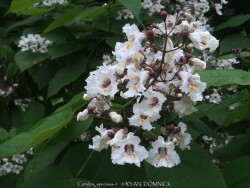

***Tree descriptions available with future update!***
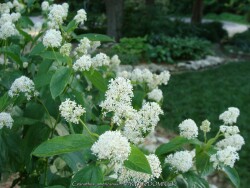

***Shrub descriptions available with future update!***
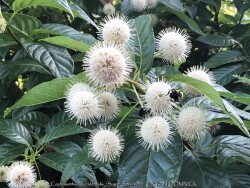

Button bush (Cephalanthus occidentalis) is a beautiful rounded shrub with glossy green leaves that turn reddish maroon in fall. White flowers are very unique (and look like a coronavirus) consisting of small spheres with protruding anthers. Bloom occurs all summer and are attractive to many different bee and butterfly species, including the swallowtail butterfly. Red fruiting heads appear in late summer adding to the ornamental appeal! In its native habitat covering most of Eastern United States including disjunct populations in Arizona, California, and Mexico, this wetland shrub can be found in low-lying areas. This includes swamps, marshes, bogs, wetlands, and along the edges of ponds, streams, and rivers. In Eastern Kansas, this is a no-brainer shrub to small tree for average garden soils including heavy clay and useful for rain gardens. Adapts to a wide range of soils except dry ones if in poor soils. Tolerant of moderate drought once established especially if in moisture-retentive rich soils. As a testament to this plants survivability, Clinton Lake and Perry Lake located in NE kansas flooded in 2020 with areas of shore-line underwater for the entire growing season. This killed every other plant species was killed except for buttonbush: all top growth was killed but new shoots from the root systems of thousands of plants along the shore resumed the following year when water receded. Basically, these plants survived over 18 months with no growth from fall of 2019 to spring of 2021. This plant can also grow in permanent standing water or as a potted plant in water gardens. Sugar Shack® Buttonbush (Cephalanthus occidentalis 'Sugar Shack') in a new Proven Winners variety! Although buttonbush has long been prized as a native and great for rain gardens, it was way too big for most landscapes. Not anymore! They cut the size in half and added improved colorful red fruit and glossy foliage. Add in cool looking, fragrant white flowers and you've got a delightful plant that shines from spring to fall. Blooming on new wood, button bush may be trimmed in early spring. Complete rejuvenation may also be done if plants get too big.


Button bush (Cephalanthus occidentalis) is a beautiful rounded shrub with glossy green leaves that turn reddish maroon in fall. White flowers are very unique (and look like a coronavirus) consisting of small spheres with protruding anthers. Bloom occurs all summer and are attractive to many different bee and butterfly species, including the swallowtail butterfly. Red fruiting heads appear in late summer adding to the ornamental appeal! In its native habitat covering most of Eastern United States including disjunct populations in Arizona, California, and Mexico, this wetland shrub can be found in low-lying areas. This includes swamps, marshes, bogs, wetlands, and along the edges of ponds, streams, and rivers. In Eastern Kansas, this is a no-brainer shrub to small tree for average garden soils including heavy clay and useful for rain gardens. Adapts to a wide range of soils except dry ones if in poor soils. Tolerant of moderate drought once established especially if in moisture-retentive rich soils. As a testament to this plants survivability, Clinton Lake and Perry Lake located in NE kansas flooded in 2020 with areas of shore-line underwater for the entire growing season. This killed every other plant species was killed except for buttonbush: all top growth was killed but new shoots from the root systems of thousands of plants along the shore resumed the following year when water receded. Basically, these plants survived over 18 months with no growth from fall of 2019 to spring of 2021. This plant can also grow in permanent standing water or as a potted plant in water gardens. Sugar Shack® Buttonbush (Cephalanthus occidentalis 'Sugar Shack') in a new Proven Winners variety! Although buttonbush has long been prized as a native and great for rain gardens, it was way too big for most landscapes. Not anymore! They cut the size in half and added improved colorful red fruit and glossy foliage. Add in cool looking, fragrant white flowers and you've got a delightful plant that shines from spring to fall. Blooming on new wood, button bush may be trimmed in early spring. Complete rejuvenation may also be done if plants get too big.
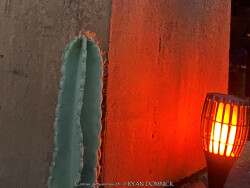

Grown for its beautiful bluish-green skin and showy night-blooming white flowers. Unlike most columnar cacti, Peruvian apple cactus (Cereus peruvianus) will bloom at a young age in a pot when about 3' tall or more. This cactus is usually grown as a patio or house plant in Kansas and blooms in late summer into early fall. Flowers only last one night! In the wild, this species is hardy to 20-25 degrees F for short periods of time. Grow in full sun with optional extra watering including that which comes from rainfall. Potted plants are very low maintenance. I have never seen any insect problems on this plant. Potted plants are capable of growing 10' tall or more in a small 7gal pot. Succulents are usually spineless and grown for their beautiful shapes, color and texture. Cacti are known for their spines, unusual shapes and beautiful flowers. Both succulents and cacti store water in their fleshy tissues. And can survive long periods without water. Cacti and succulents are usually grown as a deck/patio plant or house plant in Kansas. Grow in full sun with little to no extra watering except that which comes from rainfall. Generally, plants may be brought out in Late May through Early October in our zone 6a Lawrence, KS climate. To play is safe, potted plants are best moved in before autumn leaves begin to drop and before night temperatures get below 45 degrees F. It is very important to avoid the combination of wet and cold. Move to a bright interior window over the winter with little to no watering and keep above 50 degrees F. As a winter house plant, it will look presentable all winter long with little to no waterings. As a permanent house plant, provide bright light and allow the soil to dry completely between waterings and you will get many years of carefree enjoyment. Plants grown permanently indoors may eventually begin to elongate stretching for light and lose their spine color. It can be hard to reproduce the intense UV sunlight they need when growing indoors so moving outside for the summer is best. Generally if moving outside for the summer, allow 1-2 weeks of part shade or morning sun before placing in full sun. Plants with time to acclimate will thrive in full sun but be careful not to rush it or sunburning may occur. Repotting may or may not be needed depending on how large you want the plant to grow; plants can continue to grow taller and tolerate extremely root-bound pots but may need wind bracing. If repotting, make sure to use a sharp draining low organic cactus mix with plenty of sand and perlite but avoid peat moss. The “soil” most commercial cacti are potted in to too peaty and light weight. This soil becomes hydrophobic and shrinks after becoming bone dry and difficult to re wet again. Cacti never grow in peat-based soils in nature; this “Soil” is only good for shipping because of the light weight. Potted plants are very low maintenance but watch for scale and mealybugs that may hide beneath the cover of spines. The best pest removal approach is to periodically wash the cactus off. Achieve this with a water nozzle or hose breaker turned mostly off to increase the pressure from the blast of water. This high-pressured water kills the pests without damaging the thick cactus skin. Here are some little-known or rare factoids about cacti: 1. The "spines" are actually modified leaves filled with sap at first, then quickly drying out to form the spines! 2. Many cacti have bright colored flowers that mainly attract bees, while some tubular flowering types attract hummingbirds and bats. 3. Late on the evolutionary timeline, cacti fossils are rare to non-existent. Cacti are native almost exclusively to the Americas, while succulents can include a much larger plant palette be from any dry area in the world. 4. Some cactus plants have been known to survive more than 2 years without water. 5. Some cacti first evolved in a dry climate that later became wetter again. For example: several jungle species live as epiphytes in trees to achieve the fast drainage they need.


Grown for its beautiful bluish-green skin and showy night-blooming white flowers. Unlike most columnar cacti, Peruvian apple cactus (Cereus peruvianus) will bloom at a young age in a pot when about 3' tall or more. This cactus is usually grown as a patio or house plant in Kansas and blooms in late summer into early fall. Flowers only last one night! In the wild, this species is hardy to 20-25 degrees F for short periods of time. Grow in full sun with optional extra watering including that which comes from rainfall. Potted plants are very low maintenance. I have never seen any insect problems on this plant. Potted plants are capable of growing 10' tall or more in a small 7gal pot. Succulents are usually spineless and grown for their beautiful shapes, color and texture. Cacti are known for their spines, unusual shapes and beautiful flowers. Both succulents and cacti store water in their fleshy tissues. And can survive long periods without water. Cacti and succulents are usually grown as a deck/patio plant or house plant in Kansas. Grow in full sun with little to no extra watering except that which comes from rainfall. Generally, plants may be brought out in Late May through Early October in our zone 6a Lawrence, KS climate. To play is safe, potted plants are best moved in before autumn leaves begin to drop and before night temperatures get below 45 degrees F. It is very important to avoid the combination of wet and cold. Move to a bright interior window over the winter with little to no watering and keep above 50 degrees F. As a winter house plant, it will look presentable all winter long with little to no waterings. As a permanent house plant, provide bright light and allow the soil to dry completely between waterings and you will get many years of carefree enjoyment. Plants grown permanently indoors may eventually begin to elongate stretching for light and lose their spine color. It can be hard to reproduce the intense UV sunlight they need when growing indoors so moving outside for the summer is best. Generally if moving outside for the summer, allow 1-2 weeks of part shade or morning sun before placing in full sun. Plants with time to acclimate will thrive in full sun but be careful not to rush it or sunburning may occur. Repotting may or may not be needed depending on how large you want the plant to grow; plants can continue to grow taller and tolerate extremely root-bound pots but may need wind bracing. If repotting, make sure to use a sharp draining low organic cactus mix with plenty of sand and perlite but avoid peat moss. The “soil” most commercial cacti are potted in to too peaty and light weight. This soil becomes hydrophobic and shrinks after becoming bone dry and difficult to re wet again. Cacti never grow in peat-based soils in nature; this “Soil” is only good for shipping because of the light weight. Potted plants are very low maintenance but watch for scale and mealybugs that may hide beneath the cover of spines. The best pest removal approach is to periodically wash the cactus off. Achieve this with a water nozzle or hose breaker turned mostly off to increase the pressure from the blast of water. This high-pressured water kills the pests without damaging the thick cactus skin. Here are some little-known or rare factoids about cacti: 1. The "spines" are actually modified leaves filled with sap at first, then quickly drying out to form the spines! 2. Many cacti have bright colored flowers that mainly attract bees, while some tubular flowering types attract hummingbirds and bats. 3. Late on the evolutionary timeline, cacti fossils are rare to non-existent. Cacti are native almost exclusively to the Americas, while succulents can include a much larger plant palette be from any dry area in the world. 4. Some cactus plants have been known to survive more than 2 years without water. 5. Some cacti first evolved in a dry climate that later became wetter again. For example: several jungle species live as epiphytes in trees to achieve the fast drainage they need.


Jessamine / Hardy Cestrums are relatively new and upcomming plant. Our mix of species were purchased from Bustani Plant Farm in Stillwater, OK. Mostly listed as hardy to zone 7, you can easily push this into zone 6 with a layer of thick winter mulch. Mix of the following species proven hardy in Lawrence, KS: Cestrum aurantiacum, Cestrum ‘Greystone Gold’, Cestrum ‘Orange Peel’. Many visitors in the display garden are amazed by the uniqueness and beauty. It really resembles a "yellow flowering lilac" with flowers and foliage. Similar to a Crapemyrtle, These Cestrum varieties are hardy outside when grown as a perennial and cut back hard each year. During the growing season, fertilize, water regularly, and plant in full sun. Plant a little deep at first; about 2-3" deep with 4-6" of mulch. In our trial gardens in Lawrence, KS (zone 6a), the following varieties survived after being mulched 6-12" with leaf mulch. During the arctic blast of January, 2024, lows down to -11 degrees F on Jan 10th, 2024 were recorded. The longevity of this cold blast was also impressive: 4 days on a row with single digit highs including 1 day with a negative high(-2F), 4 nights of lows in negatives(-8For lower), and 48 straight hours of 0 degrees F and mostly lower.


Jessamine / Hardy Cestrums are relatively new and upcomming plant. Our mix of species were purchased from Bustani Plant Farm in Stillwater, OK. Mostly listed as hardy to zone 7, you can easily push this into zone 6 with a layer of thick winter mulch. Mix of the following species proven hardy in Lawrence, KS: Cestrum aurantiacum, Cestrum ‘Greystone Gold’, Cestrum ‘Orange Peel’. Many visitors in the display garden are amazed by the uniqueness and beauty. It really resembles a "yellow flowering lilac" with flowers and foliage. Similar to a Crapemyrtle, These Cestrum varieties are hardy outside when grown as a perennial and cut back hard each year. During the growing season, fertilize, water regularly, and plant in full sun. Plant a little deep at first; about 2-3" deep with 4-6" of mulch. In our trial gardens in Lawrence, KS (zone 6a), the following varieties survived after being mulched 6-12" with leaf mulch. During the arctic blast of January, 2024, lows down to -11 degrees F on Jan 10th, 2024 were recorded. The longevity of this cold blast was also impressive: 4 days on a row with single digit highs including 1 day with a negative high(-2F), 4 nights of lows in negatives(-8For lower), and 48 straight hours of 0 degrees F and mostly lower.


***Description for this plant available with future update!***
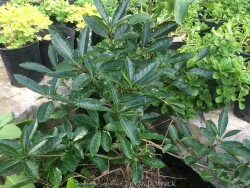

***Description for this plant available with future update!***Fringe Tree, is also known as Chionanthus virginicus


***Description for this plant available with future update!***Milky Way Spider Plant (Tropical), is also known as Chlorophytum comosum 'Milky Way'
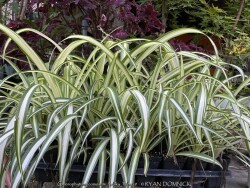

***Description for this plant available with future update!***Milky Way Spider Plant (Tropical), is also known as Chlorophytum comosum 'Milky Way'
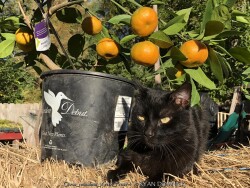

Arctic Frost Hardy Satsuma (Citrus reticulata 'Arctic Frost') is typically grown in warmer zones as far North as Dallas (Zone 8a). Along with other tropicals and succulents in Kansas, Arctic Frost is usually grown as summer patio plant and then moved inside for the winter. Move to bright area in a cold garage, basement, or window over the winter with monthly watering. During the growing season, water regularly and place in full sun. If grown in a larger 20 gallon pot or so, it may flower and fruit when 4-5 feet tall after a few years. Before hard freezes come in the fall, move inside to protect from temperatures below 25 degrees F if you want fruit. Flower buds form in the winter on citrus trees. If you want evergreen foliage, protect with anything lower than 15 degrees F. It will tolerate down to 10 degrees F with complete defoliation and around 0 degrees F with complete wood kill down to the base of the trunk. Because it is grown on its own root system, it will come back true from winter kill down to the ground. A plant in our Lawrence, KS cold frame survived 0 degrees F for a few days and grew 3-4' back the following year. Don't expect flowers and fruit in these conditions though.
